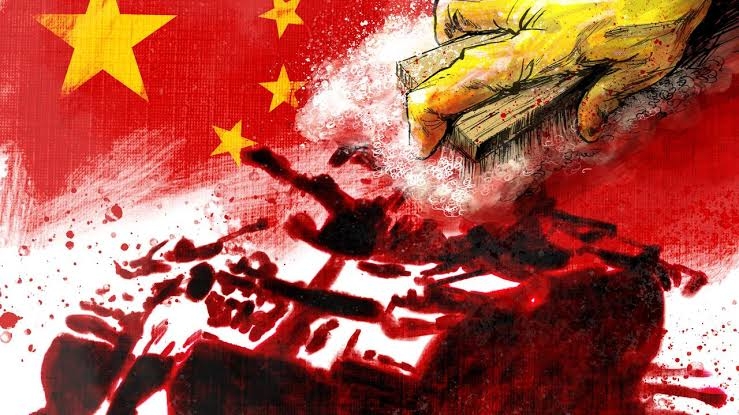Tiananmen Square is not an incident, but an ideology in itself, OBOR is an example

George Orwell, the legendary writer who was known for his books ‘Animal Farm’ and ‘1984’ amongst several others, remarked “One does not establish a dictatorship in order to safeguard a revolution, one makes a revolution in order to establish a dictatorship.” The quote has proved prophetic, when one looks at China’s contemporary history. (also, who knows we might have similar examples in China’s ancient history as well?)
After a communist ‘revolution’ under Mao Zedong in 1949, China became a dictatorship in yet another predictable example of a communist revolution gagging democracy to establish a ‘red caliphate.’
Thus, the Tiananmen Square massacre of 1989, in the spectrum of China’s political history, is not a separate disjoint event. The massacre is not a random crest on a graph but the inherent plane on whose tenets the Chinese state has been built. The massacre is not an incident but an ideology in itself.
The same ideology made China annex Tibet in pre-Tiananmen times and claim South China Sea as its legitimate area. It made China attack India (aided by the incompetence/connivance of a socialist/communist regime and ‘red revolutionaries’ in India, of course) in 1962 and be negligent in its containing the coronavirus outbreak which has engulfed the entire world today.
The same ideology lies behind Chinese President Xi Jinping’s flagship project – Belt and Road Initiative. What is the main tenet of this ideology? It is “Establishing a Sino-centric world with the Communist Party of China reigning supreme.”
To see through China’s malevolent motives behind its BRI project, let’s contrast it with the Marshall Plan of the US and India’s development and infrastructural work in the war torn nation of Afghanistan.
The Marshall Plan, as History.com mentions “also known as the European Recovery Program, was a U.S. program providing aid to Western Europe following the devastation of World War II. It was enacted in 1948 and provided more than $15 billion to help finance rebuilding efforts on the continent.
The brainchild of U.S. Secretary of State George C. Marshall, for whom it was named, it was crafted as a four-year plan to reconstruct cities, industries and infrastructure heavily damaged during the war and to remove trade barriers between European neighbours – as well as foster commerce between those countries and the United States.” It has been more than seventy years since the plan came into being. But has there been a single case of an aid-receiving European country that has lost its sovereignty (in full or part thereof) to the US?
Has there been a single case of a country which has become saddled with insurmountable debt to be repaid to the US? Has any country in the plan being debt-trapped? The answer is no. Why? Simply, because it’s not China who drew up the plan. If it would have, the world would have seen multiple ‘Sri Lankan Hambantotas’ ,‘Burmese Kyaukpyus’ and ‘Pakistani Gwadars’ spread across Europe that would have been completely debt-trapped. Thus, it’s not infrastructure and development that has accompanied the Chinese BRI, but an Sino-military expansion coupled by debt-diplomacy.
When India assisted Afghanistan in constructing the latter’s parliament at the cost of $90 million, India did not make an ‘agreement with any hidden clauses’.
Though the parliament project was a gesture of India’s admiration and friendship with Afghanistan and not a business project, India, keeping in line with its millennia old principle of “Vasudhaiv Kutumbakam (World is a family)”, has never duped other countries into accepting its aid comprising of devious clauses threatening the sovereignty of recipient nations.
Whereas the BRI stands in complete contrast and reveals, through its impact, the dragon’s ball of fire!
Thus, the Belt and Road initiative is the modern day Tiananmen Square, which the world has to take collective action against, in order to ensure that it doesn’t turn into a massacre. Uptil now, such ‘collective action’ has been existing only on papers, reports and speeches.
No formal or concrete action of value against the initiative has been taken. Though there exists a ‘quad’ grouping of India, US, Japan and Australia to combat China’s ambition of dominating the Indian Ocean by furthering BRI projects in various oceanic island-nations, the arrangement is anything but ‘formal’.
Thus, despite having the requisite resources and potential to combat the dragon, the world’s diplomatic and geo-strategic plane is a criss-cross network of conflicting interests and incentives, despite decades of the US led international order being functional. Hence, building an international consensus to combat China’s neo-colonialism is the need of the hour. Otherwise, China is coming with another Tiananmen Square massacre. Only this time, the square is ‘spherical’ in shape and the protesters are the sphere’s 7.8 billion people.
Article by
Deepanshu Agrawal